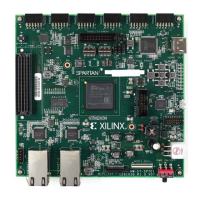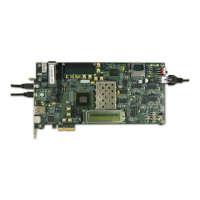228 www.xilinx.com 7 Series FPGAs GTP Transceivers User Guide
UG482 (v1.9) December 19, 2016
Chapter 5: Board Design Guidelines
Power Supply and Filtering
Overview
The Artix-7 FPGA GTP Quad requires two analog power supplies: MGTAVCC at a nominal voltage
level of 1.0 VDC, and MGTAVTT at a nominal voltage level of 1.2 VDC. The pins for each of these
analog power supplies are tied to a plane in the package. In some packages, there are two planes for
each of the analog power supplies. See Analog Power Supply Pins, page 219 for a discussion of the
internal power planes in the Artix-7 FPGA GTP packages.
Noise on the GTP analog power supplies can cause degradation in the performance of the
transceivers. The most likely form of degradation is an increase in jitter at the output of the GTP
transmitter and reduced jitter tolerance in the receiver. Sources of power supply noise are:
• Power supply regulator noise
• Power distribution network
• Coupling from other circuits
Each of these noise sources must be considered in the design and implementation of the GTP analog
power supplies. The total peak to peak noise as measured at the input pin of the FPGA should not
exceed 10 mV
PK-PK
.
Power Supply Regulators
In many applications, the GTP analog voltage supplies have local power supply regulators that
provide a final stage of voltage regulation. Preferably these regulators are placed as close as is
feasible to the GTP power supply pins. Minimizing the distance between the analog voltage
regulators and the GTP power supply pins reduces the opportunity for noise coupling into the supply
after the regulator and for noise generated by current transients caused by load dynamics.
Linear vs. Switching Regulators
The type of power supply regulator can have a significant impact on the complexity, cost, and
performance of the power supply circuit. A power supply regulator must provide adequate power to
the GTP transceiver with a minimum amount of noise while meeting the overall system thermal and
efficiency requirements. There are two major types of power supply voltage regulators available for
regulating the GTP analog voltage rails; linear regulators, and switching regulators. Each of these
types of regulators has advantages and disadvantages. The optimal choice of regulator type depends
on system requirements such as:
• Physical size
• Thermal budget
• Power efficiency
• Cost
Linear Regulator
A linear regulator is usually the simplest means to provide voltage regulation for the GTP analog
supply rails. Inherently, a linear regulator does not inject significant noise into the regulated output
voltage. Not all linear regulators provide noise rejection at the output from noise present on the
voltage input. Another advantage of the linear regulator is that it usually requires a minimal number
of external components to realize a circuit on the printed circuit board.
